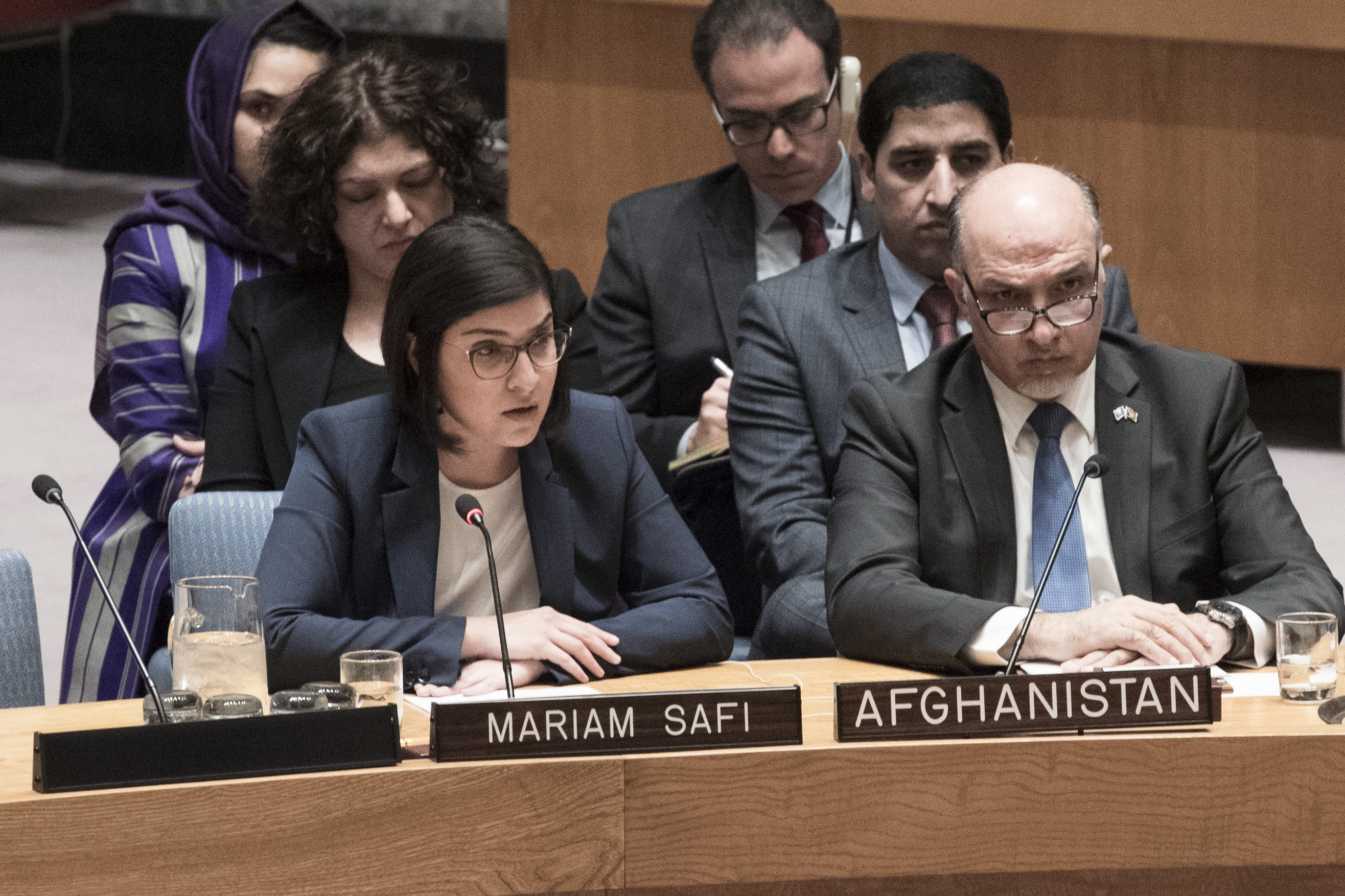Madam President, Your Excellencies,
Thank you for giving me the opportunity to address the Security Council. I would like to thank the Netherlands, as the president of the Security Council this month, for inviting me to share my perspectives on the Afghan peace process.
Today, in my capacity as a peacebuilder and member of the research community in Afghanistan, I would like to touch on the current trends, conditions on the ground, and key issues relating to the Afghan peace process. The perspectives I will be sharing with you have been deeply informed by a decade of consultations, I have led as part of our efforts at the Organization for Policy Research and Development Studies, with diverse sectors, community members, and the brave and resilient women of Afghanistan.
Afghanistan has witnessed great progress since 2001. This is reflected in the emergence of a bright and vibrant new generation of youth, the representation of women in all sectors of Afghan society and the strengthening of a promising democratic system of governance.
Seventeen years ago, hope replaced despair, and Afghans embarked on the path towards a peaceful and stable future where conflict would become a distant memory. We welcomed the international investment and commitment to support this hope. But as I speak here before you, I must tell you that hope is beginning to fade.
The theater of conflict is getting more confusing, complicated and lethal. In 2001, we were fighting one group, now we are fighting over 20 regional and international terrorist groups. Safe zones have now become battlefields that extend from rural to urban areas.
The Taliban, its affiliated group the Haqqani Network and fighters affiliated to ISIL are now targeting civilians, including women and children. In 2009, 285 women were killed. In 2017 that number rose to 1224.1 This is extremely alarming. Let us not forget last year’s killing of 9-year old Shukria, who while traveling with her family from Quetta to Ghazni province, was stopped by insurgents, held captive and was later beheaded. This incident prompted nation-wide protests and made it very clear that Afghans would not tolerate impunity for those targeting civilians.
Despite the Taliban committing to a code of conduct on the protection of civilians in 2014, the group continues to carry out attacks in densely populated areas showing no regard for civilian lives. I implore the Security Council and the international community to ensure that transitional justice is not compromised in the pursuit of peace and reconciliation. The peace deal with Hizb- I-Islami, signed in September 2016, showed that peace is possible in Afghanistan. However, it also showed how easily actors could sideline the need for community healing, exclude women and civil society engagement and take steps that reinforce a culture of impunity in the pursuit of achieving that peace.
While security challenges remain the predominant source of concern, it is not the only cause of despair for Afghans. Our recent findings indicate that insecurity and political instability go hand in hand, and are the two primary drivers for Afghans fleeing. For the first time in Afghanistan’s history, we are now witnessing young single women, making up a significant portion of those taking the dangerous journey out of the country.
As Dr. Sarabi has just described, the Second Round of the Kabul Peace Process culminated last week with the Afghan government presenting to the Taliban, for the very first time, a detailed ‘Offer of Peace’. While there has long been a national consensus on the need for peace among Afghans, there still remains serious and different concerns on the best way forward on how that peace should unfold.
Fundamental questions remain on:
o Whether the time is right for such negotiations?
o What are the red lines for negotiations?
o What would justice look like in an eventual settlement?
o How will the rights of women be upheld and protected?
o How will the participation of women in all levels be guaranteed in the
implementation and monitoring of any agreement reached?
o What is the way forward AFTER a peace agreement is reached?
o And, what will that peace MEAN to different sectors of Afghan society?
For Afghan women, it is imperative for the state to define the type of peace that would ensue from negotiations. Our findings show that women believe that the future of their rights are intricately tied to the outcomes of the peace process. Habiba from Kunduz province told us, “The achievements of the last 17 years in women’s empowerment, freedom of speech, human rights and civil values, should not be open for negotiation.” On the question of reintegrating ex- combatants, those particularly living in rural areas, expressed fear of an escalation of violence and renewed suppression against women. How those reintegrated would be monitored after a peace agreement is a huge source of concern.
The Afghan government’s launch of the National Action Plan on United Nations Security Council resolution 1325 on Women, Peace and Security offered great possibilities in the promotion of women’s involvement in all areas related to peace and security. However, its implementation continues to suffer setbacks rendering women’s voices as symbolic in decision- making levels. For example, while gender units have been created within most ministries and legal structures, they lack the necessary tools and budget required to carry out the mandate of 1325. The time has come to expand women’s roles from one of mere presence to active engagement, consultation and inclusion. The United Assistance Mission to Afghanistan (UNAMA) in cooperation with the Afghan government and civil society organizations, must identify where the bottlenecks lie and adopt concrete and genuine measures to address these gaps, only then can we create spaces where women, both formally and informally, are able to realize their agency.
There is also a disconnect between the rhetoric of local ownership and how it is actually implemented. The selective nature with which the High Peace Council chooses the narratives it incorporates into its peace agenda, the civil society actors it decides to engage with, and the priorities it selects to focus on, have led many to question its legitimacy, credibility and objectivity.
Real and meaningful progress notwithstanding, the Afghan government remains weak with financial, security and internal strife mounting, thus we must be cognizant that any proposed changes to the Constitution as a result of a peace agreement with the Taliban must not erode the rights and freedoms of all Afghan citizens. I appeal to the Security Council to closely monitor any amendments to the Constitution, ensure that the sequencing of peace-making activities and overtures are supported with confidence-building measures from the Taliban, and lastly facilitate greater engagement between the HPC and diverse sectors of Afghan society to ensure all narratives are represented and supported through a national consensus.
Lastly, past experiences show us that supporting an Afghan-led and owned peace process is not enough to prevent and combat terrorism. When we asked women at the rural level what they saw as an obstacle to achieving peace in Afghanistan, almost all highlighted regional interferences. The Security Council and the international community must persuade Pakistan to engage constructively in all efforts to curb the threat of terrorism and support an intra-Afghan dialogue for peace.
Afghanistan’s international partners have repeatedly expressed their intention and will to stand behind the people of Afghanistan to bring lasting peace, security and stability. Today I urge you to stand beside us, not behind us.
Thank you.



